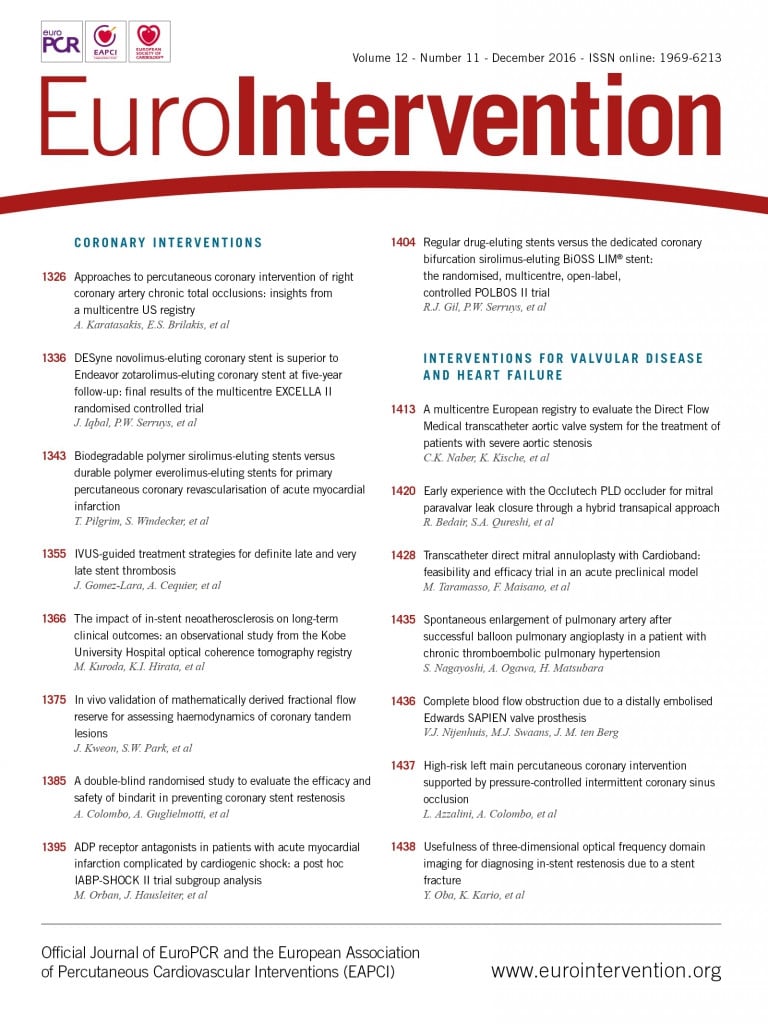
Exercise-induced myocardial ischaemia is a major prognostic indicator, and reliable assessment is a daily challenge1,2. Simple angiography sheds no light on ischaemia risk in coronary stenosis3, as accuracy is only 65%, compared to 95% with adenosine-derived fractional flow reserve (FFR)4. Moreover, coronarography is usually performed without a preliminary non-invasive test or with ambiguous results, especially in multivessel disease5.
An exemplary, rigorous step-by-step methodology by Nico H.J. Pijls and Bernard De Bruyne has been implemented for 20 years now, covering all pathophysiological stages of functional assessment of atherosclerotic epicardial coronary stenosis.
Clinical studies of FFR have explored the various clinical situations of stable coronary disease managed by angioplasty. Prognosis is known to be better in single-vessel than in multivessel involvement6,7.
Spatial discrimination has progressively improved in FFR, from simple single-vessel to multivessel (≥2 vessels) focal lesions. FFR also interprets the functional significance of diffuse single-vessel or multivessel atherosclerotic coronary penetration, by pullback pressure tracing8. Patients with diffuse penetration not eligible for interventional or surgical revascularisation are at much greater risk of cardiovascular events than the general population9.
In the current issue of EuroIntervention, the excellent article by Kweon et al10 makes an elegant contribution, with a relatively sophisticated FFR method of discriminatory analysis of tandem coronary lesions. The association of two lesions, “in series” or “in tandem”, on an epicardial coronary vessel axis constitutes a double epicardial resistance that is fairly easy to assess overall on FFR; discriminating the respective functional impact of each lesion, however, is trickier11. Fluid dynamics, spatial flow pattern and the effect of side branches between the lesions greatly complicate the subtle interaction between lesions, as Barlis et al showed on an elegant dynamic computational simulation12. The principles of functional analyses of serial epicardial stenosis were also published by Bernard De Bruyne13 and Nico H.J. Pijls14, who developed two mathematical formulations predicting the functional impact of each stenosis, integrating the disturbance caused by the other. The proximal FFR gradient could be underestimated due to the downstream lesion increasing the pressure between the two stenoses (Pm). Therefore, four pressure readings are needed: proximal, intermediate (Pm), distal and wedge pressure. Coronary wedge pressure reading requires balloon occlusion to calculate FFR for each stenosis. In daily clinical practice when distal FFR is ≤0.80, most interventional cardiologists recommend first treating the lesion which would induce the greatest pressure drop. In the study by Kim et al, PCI was deferred in 182 out of 298 lesions (61%), based on FFR; only 26 vessels (18.4%) required more than two stents15.
Kweon et al describe an original predictive mathematical model taking account not of wedge pressure but rather distal main branch flow fraction (k) when the tandem stenoses lie either side of a side branch. The authors provide a clear mathematical demonstration of their predictive model, with in vivo validation in 50 patients with 50 tandem lesions. They present a comparison versus conventional models (De Bruyne and Pijls). After stenting one of the two lesions, final FFR was compared against that predicted by the model: it clearly emerged that the new model provided a coefficient of determination R2 of 0.87, significantly better than R2=0.57 using the old conventional model. In other words, the independent variable (predicted FFR) explained 83% of the variation in the dependent variable (measured FFR). Moreover, on Bland-Altman plots, the variation in uncertainty of predicted versus measured FFR was much lower. In other words, for FFR=0.8 (threshold), the uncertainty of prediction ranged between 0.68 and 0.92 using the conventional model, and 0.73-0.87 with this new mathematical model. The big difference from the conventional model of De Bruyne and Pijls lies in integrating distal main-branch flow fraction estimated from quantitative angiographic measurement of the two daughter-vessel diameters.
Finally, to facilitate clinical decision making in selecting the treatment strategy for the two lesions, the authors provide a double-entry table, taking account of the two drop pressures (∆FFR) for the two tandem lesions. The treatment strategy can then be selected, treating only the proximal or only the distal lesion or both. The study, of course, presupposes that distal FFR is <0.8. There is no doubt as to the complexity of the interaction between tandem lesions, flow variation around bifurcations, impact of bifurcation angle on daughter-vessel flow fraction16, and interaction between the two lesions in terms of flow variation17. However, this article, remarkable in design and highly contributive to everyday practice, takes us one step nearer to precise spatial determination of the functional impact of multiple stenoses.
In other words, this paper suggests that everyday use of FFR is shifting from Prêt-à-Porter to Haute Couture.
Conflict of interest statement
The authors have no conflicts of interest to declare.

